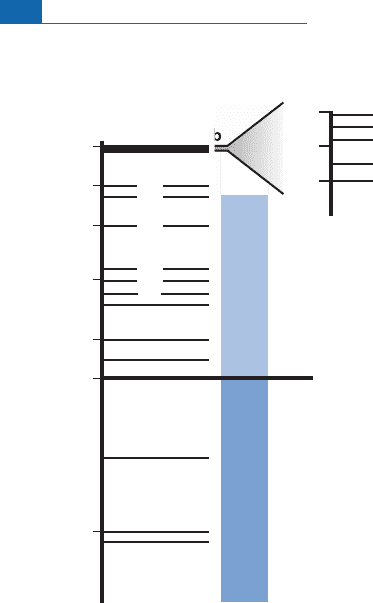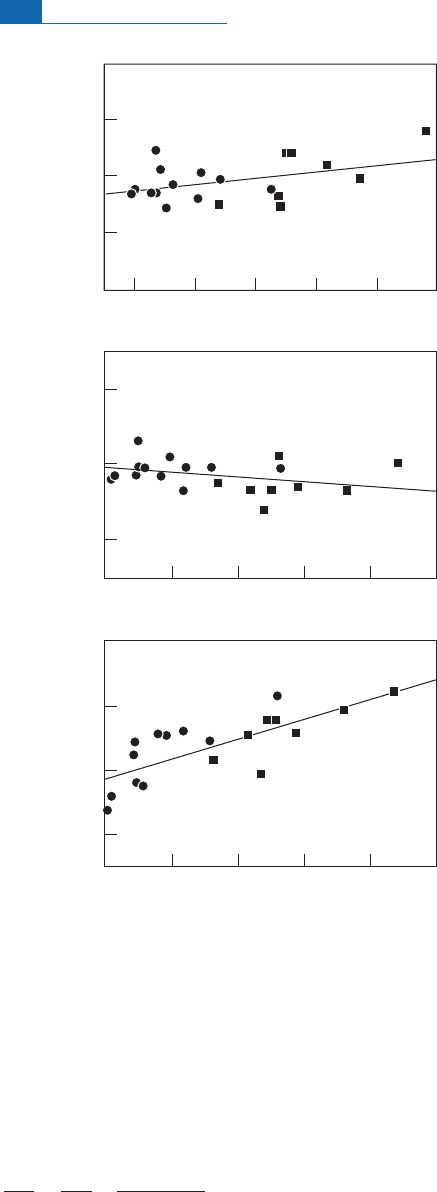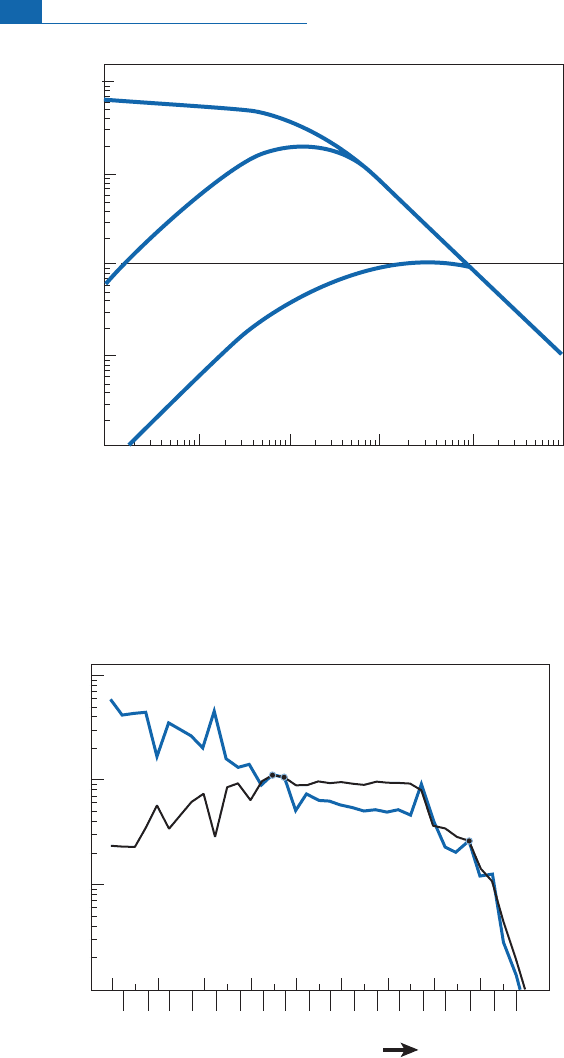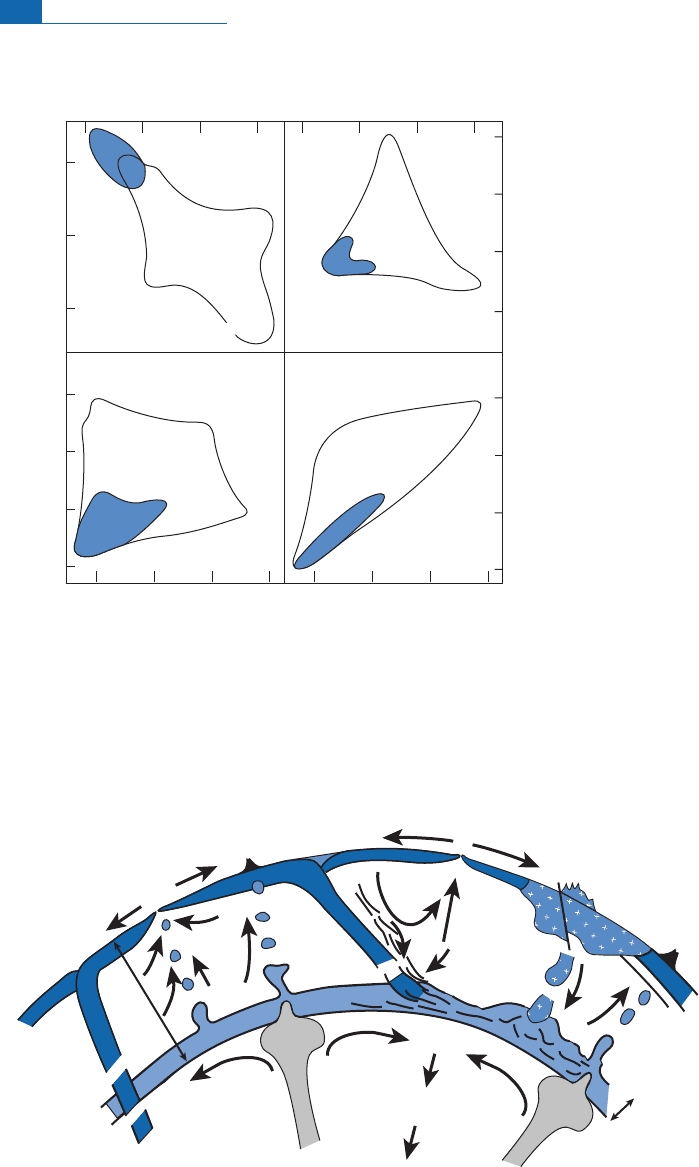All?gre Claude J. Isotope Geology
Подождите немного. Документ загружается.


comes from the d epleted upper mantle, and let us calculate the composition of the‘‘recon-
structed’’primitive mantle (Table 6. 1 0) before extraction ofthe continental crustby mixing
ofcontinental crustwith depleted mantle:
½A
primitive
¼½peridotite0:99 þ½granite0:01:
This composition is almostidenticaltothatofthe peridotite analyzed.The on lyelement for
whichadi ¡erence canbe clearlyseen is potass ium, which isnot a major element! T hose dif-
ferencein composition cannotbe distinguishedbyanygeophysical,seismological, orgravi-
metric m easurements.
Remark
Remember this warning in chemical geodynamics: minor elements mean major problems. Whereas
in petrology, major elements mean key problems!
We have translated this in Figure 6.67, remembering we have calculated factorsW.Itwill
berecalledthat:
W
i
¼
m
i
cc
C
i
cc
m
i
p
C
i
p
where m
cc
i
is the mass of continental crust, and m
p
i
is the mass of the primary mantle
before depletion; we can take it to be equal to the upper mantle, such that m
cc
/m
p
¼0.015;
Table 6.9 Composition of granite and of peridotite of the mantle
Oxide Element Peridotite Gran ite
percentweightof
oxide
percentweight
ofmajor
element
perc ent weight
ofoxide
percentweight
ofmajor
element
O43.36 50.38
SiO
2
Si 41.8 2 0.80 19.51 72.30 0.50 3 3 . 1 3
Al
2
O
3
Al 3.50 0.10 1.26 14.15 0. 10 5 . 094
Fe
2
O
3
Fe 9.06 0. 15 6.33 1 .91 0.02 1 .3 3
MgO Mg 37.9 9 0.5 22.86 0.040 0.008 0.03
MnO Mn 0.17 0.01 0.1 4 0.370 0.001 0.22
CaO C a 3.02 0.06 2. 15 1 .3 3 0.01 0.949
Na
2
ONa 0.820. 1 0.6 3.49 0.03 2.589
K
2
OK 0.030.006 0.0250 2.55 0.06 2. 1 2
Table 6.10 Composition of the primitive mantle
OSiAlFeMgMnCaNaK
‘‘Reconstructe d’’prim itive
mantle(%)
43.4219.641.2986.2822.6030.13892.1370.61980.4595
Depletedmantle 43.36 19.51 1.26 6.33 22.86 0.14 2.15 0.6 0.025
329 Chemical geodynamics

C
cc
i
is the concentration of element i in the continental crust, C
p
i
is the concentration of
element i in the primitive mantle, and W is the proportion of the element concentrated
in the continental crust.
20
It is possible to calculateW fora few majorand minorelements.The scale (in log
10
) is sepa-
rated in two by the values ¼0.015; an element that does not fractionate between crust and
mantlehas this value. Above this value the element is enriched in continental crust; below, it
is depleted. It shall be seen that while silicon and manganese are not very di¡erent from it,
below the elements are enriched in the mantle, while above they are enriched in the crust.
Tab l e 6. 1 1givesthevalues ofthe various isotope ratios that canbeus ed for studying the conti-
nental crust^mantlesystem.
Hofmann’s two-stagemodel
Hofmann (1988) develope d a simple model that gives a p rettygood accountofthe chemical
composition of the continental crust, th e oceanic crust, and the upper mantle. Although
u nsophisticated, it does allow us to g et our thinking straight. It assumes, as already estab-
lished, that the continental crust became di¡erentiate d from the p rim itive mantle through
1.0
0.4
0.15
0.06
0.045
0.015
0.0004
Os
Mg
Fe
Mn
Si
Al
Na
Th, Rb, K, U, Pb
W
W
1.0
0.8
0.9
Th
Rb
K, U
Pb
Enriched elements
in the crust
Enriched elements
in the mantle
Φ
Sr
Hf
Nd
Re
Lu
Figure 6.67 The
W
scale for some elements.
W
is the fraction of an element contained in the
continental crust relative to the sum total (crust þupper mantle), and is the proportion by mass of
the lower mantle–upper mantle. It separates the elements enriched in the crust from those enriched in
the mantle.
20
We know it is an approximation because the mass of the depleted mantle is greater than that of the
upper mantle. However, it helps to get our ideas straight.
330 Radiogenic isotope geochemistry

partial meltingwithadegreeofmeltingF
1
andthatthisextractionleftadepletedmantle. The
depleted mantle then underwent a second stage of partial m elting i n much more recent
times with a degree of melting F
2
. For example, the di¡erentiation of the continental crust
may have a mean age of about 2 Ga.The di¡erentiation of ocean crust is far more recent,
less than100 Ma.
Theequationswithwhichto computesucha modelarestraightforward.Webeginwiththe
formulaforthe creationofmeltbypartial meltingatequilibrium,assumingthatth e compo-
sitionofthis meltrepres entsthe average composition ofthe continentalcrust:
C
i
e
¼
C
i
0:s
D
i
s
=
1
þ F 1 D
i
s
=
1
where C
e
i
is the concentration of element (i)inthemelt,C
i
0:s
is the concentration in th e
initial solid, D
i
s
=
1
is the fractionation factor between the magmatic melt and the residual
solid , and F is the degree of partial melting.
After the ¢rst melting episode producing the continental crust with a degree of melting
(F
1
), the concentration foran element (i) ofthe residual mantle is:
C
i
s
¼
D
i
s
=
1
C
i
0:s
D
i
s
=
1
þ F
1
1 D
i
s
=
1
:
If the residual solid is subj ected to a new melting episode, the concentration of the melt
(magma) foran element (i) iswritten:
C
i
1
2
¼
D
i
s
=
1
C
i
0:s
D
i
s
=
1
þ F
1
1 D
i
s
=
1
D
i
s
=
1
þ F
2
1 D
i
s
=
1
:
Table 6.11 Average isotope ratios of the three reservoirs of the silicate
Earth
Continental crust Depletedmantle Primitive mantle
87
Rb/
86
Sr 0.35 0.0014 0.087
87
Sr/
86
Sr 0.7123 0.7021 0.70475
147
Sm/
144
Nd 0. 1 1 0.252 0. 1975
143
Nd/
144
Nd 0.51155 0.51330 0.51265
176
Lu/
17 7
Hf 0.0073 0.0459 0.0333
176
Hf/
177
Hf 0.281 69 0.28343 0.28287
187
Re/
188
Os 3 7 .54 0.3622 0.3850
187
Re/
186
Os 312 3.01 3.20
187
Os/
188
Os 1.40 0.1251 0.1254
187
Os/
186
Os 11.7 1.040 1.0422
238
U/
204
Pb 9.58 5.77 8.78
232
Th/
238
U 4.55 2.54 4.27
206
Pb/
204
Pb 18.59 17.43 18.34
207
Pb/
204
Pb 15.586 15.42 15.55
208
Pb/
204
Pb 39.56 37.13 39.05
331 Chemical geodynamics

The degree of melting needed to pro duce the continental crust may be estimate d
from the concentration of the most highly magmaphile elements (rubidiu m, barium,
thorium) in the crust. For such elements, the coe⁄cient D
s
=
1
is close to zero so that the
equation
C
i
1
¼
C
i
0
=
s
D
i
s
=
1
þ F 1 D
i
s
=
1
reduc es to
C
i
1
C
i
0
=
s
F
:
Since the average concentration of these elements in the continental crust is
approximately
C
i
1
C
i
0
=
s
100
weobtain a meltfraction of
F
1
0:01:
We can then calculate empirical partition (fractionation) coe⁄cients for all the other ele-
ments fro m their estimated mean concentrations in the continental crust, C
l
,thevalueof
F
1
¼0.01, and the initial bu lk mantle composition C
0
, using the equilibrium melting equa-
tion. Finally, we can calculate the composition of the second melting event produc ing the
o ceanic crust using these formulae with the same partition coe⁄cients and letting F
2
vary
around 0.1.
This is the approach Al Hofmann took in 1988. Hofmann assumed, and this is his b ig
hypothesis, thatfractionation coe⁄cients are identical for the creation of both continental
cru st and oceanic crust.The model thereforegives an exclusive role to partial meltingofthe
mantle. Again, this hypothesis is debatable and even simplistic, but it does have the advan-
tageofbeing clearandofsettinglimits and providing abenchmark forother more elaborate
mo dels.
Because there aregood reasons to thinkthatthe processes forming the continental crust
are more complex thanjust simple, equilibrium partial melting, Hofmann et al.(1986)also
used an alternative method for determining solid^li quid fractionation factors. This
methodisbased entirelyon observationsfrom naturallyoc curringoceanicbasalts.
For thispur pose, heuseda methodoriginally proposedbyMichel Treuil foranother use.
Supposethatthe partial meltingformula mightbeapproximatedby:
C
i
1
¼
C
i
0
D
i
s
=
1
þ F
where C
1
i
is the concentration of element (i) in the liquid , and C
0
i
the concentration of ele-
ment(i) inthe initialsolid.
332 Radiogenic isotope geochemistry

This means consideringthatD
s
=
1
iss mallrelativetotheunitinthegeneral formula.We can
then write the ratio between two elements for which this approximation can be made,
whichwe note (i)and(j):
C
ðiÞ
1
C
ðjÞ
1
¼
C
ðjÞ
0
C
ðiÞ
0
þ
D
ðiÞ
s
=
1
D
ðjÞ
s
=
1
C
ðiÞ
0
C
ðjÞ
1
:
Zr/Sm
Zr (ppm)
Hf (ppm)
MORB
OIB
35
30
25
20
80 120 160
R = 0.48
200 240 280
Hf/Sm
MORB
OIB
1.0
0.8
0.6
324567
R = 0.31
Hf (ppm)
Hf/Eu
MORB
OIB
2.4
2.8
2.0
1.6
324567
R = 0.78
Figure 6.68 Illustration of Hofmann’s second method for determining the fractionation factors of the
various magmaphile elements. The slope defines the relative value of the solid/magma fractionation
factors. It is seen here that
D
Zr
>
D
Sm
,
D
Sm
>
D
Hf
, and
D
Hf
>
D
Eu
.
333 Chemical geodynamics

Normalized concentration
D
Primitive mantle
F
1
= 0.016 Continental crust
Residual mantle
F
2
= 0.01
100
10
1
0.1
0.0010.0001
0.01 0.1 1 10
Figure 6.69 Hofmann’s calculation to explain the composition of continental crust and oceanic crust.
After Hofmann (1988).
Normalized concentration
Compatibility
(oceanic basalts)
MORB
Continental
crust
10
Rb Th
Ba
Rb Ce Pr Sr
Sr
Hf Ti
Ti
Gd Dy Y Tm Lu Al Sc Fe Co Ni
U K La Pb
Pb
Nb
(Ta)
Nd Sm Zr Eu Tb Ho Er Yb Na Ca Cu Si Mg
100
1
0.1
Figure 6.70 Actual distribution of the composition of continental crust and of MORBs. Notice the
anomalies for niobium, (tantalum), lead, strontium, and titanium. From Hofmann (1988).
334 Radiogenic isotope geochemistry

This equation, from whichthe melt fraction F hasbeen eliminated, gives the concentration
ratios of two elements in the melt as a function of their respective ratio in the source and of
their partition coe⁄cients.
Ina C
i
1
=C
i
1
; C
j
1
diagram, th atis aratio ofelements asafunctionofthe concentration of
one element in the liquid (magma), the process is represented by a straight line whose
slope is proportional to D
j
s
=
1
D
i
s
=
1
.IfD
j
s
=
1
4
D
i
s
=
1
, the slope i s positive and vice versa. It c an
be seen then that by plotti ng the ratios between two elements as a function of the concen-
tration of one of them, it can be determined whether D
j
s
=
1
is g reater than or l ess than D
i
s
=
1
(Figure 6.68).
This approach of estimating the relative magnitudes of the partition coe⁄cients can
be used to test the above crust^mantle di¡erentiation model: if we plot abundances
on the y-axis and the sequence of chemical elements on the x-axis, ordered according
to their decreasing solid^liquid fractionation factors, there should be no major dis-
continuities for MORBs. Hofmann et al. (1986) also calculated theoretical m odels
(Figure 6.69).
When th e calculations are compared with actual ob servations, it can be seen that the
mo del does not re£ect the observations exactly although the di¡erence is not great
(Figure6.70).
(1) Elements with very low fractionation factors are more abundant in the real world
than in the model. Hofmann et al. (1986 ) overcame this di⁄culty by assuming that a
small partofthe melt is retained in the mantle.T his is an ad hoc hypothesisbutthereis
no reason to rule it out since, through erosion and subduction, this process certainly
occurred.
(2) Th e second di⁄culty concerns the elements Nb and Ta, Ce and Pb, S r and Ti, which
‘‘cause’’ peaks or valleys in the abundance diagram. Hofmann et al. (1986) ascribed
these‘‘anomalies’’ to the factthat the actual fractionation factors involved in the di¡er-
entiation of continental crust and those involved in the di ¡erentiation ofoceanic crust
arenot identical.This relatesbacktothe di¡e rencebetweenth e R- and the S-processes,
one without water, the other withwater.
Accordingly, Hofmann’s approach is interestingfor teaching p urpos es.Itshowsthatwith
a very simple model, the general relationship s between c ontinental and oc eanic crust can
be reasonably well modeled, butthat aprec ise description involves disti nguishingbetween
di¡erentiation of continental crust and partial melting occurring at the mid-ocean ridges.
It is agood exampleofmodeling tomeditateon.
6.6.8 The origin of MORB and OIB and the mantle structure
Letusturnback now tothequestionofthe originofoceanicbasalts. Letus examinethe pro-
blem of the origin of the two main types ofoceanic basalt, MORB and OIB, on the basis of
the statistical distribution of their isotope composition. Both types of basalt are the result
of a threefold process: partial melting of the mantle, col lection of magma, and transfer to
335 Chemical geodynamics

the surface.These three processes apply to a mantle source made up of the mixing of thin
folded layers of a basaltic component (eclogite) i n an ultrabasic matrix (peridotite). We
k now from petrological experiments (partial melting experiments in the laboratory in var-
iedconditionsofpres su reandtemperature) thattheMORBs correspondtoagreaterdegree
ofpartialmelting(5^10%)thantheOIBswhichareclose r to0.1^1%.Th ereforeOIBssample
a larger volume of mantle pe r cubic meter of magma than MORBs do. But on the other
hand,thevolumegiven outby the ocean ri dges (MORB) is so muchgreater thanthevolu me
from plumes (OIB) that a much greater volumetr ic proportion of the mantle is sampled by
the MORBsthanbythe OIBs.
Exercise
Calculate the volume of mantle sampled in 5 million years by the MORB. What proportion
does that correspond to for the upper mantle?
Answer
4 10
7
m(ridgelength) 4 10
2
(spreading) 6 10
4
(thickness) 3.2 10
3
(density)
5 10
6
(duration) 10 ¼1.5 10
22
kg. Now, the mass of the mantle is 1 10
24
kg, there-
fore more than 100% is sampled in 500 Ma. If the sampling were random, all of it would
be sampled! (But in practice some domains are sampled several times because of
recycling.)
That said, the statistical distribution of
87
Sr/
86
Sr,
4
He/
3
He, or
206
Pb/
204
Pb isotope ratios
for MORB and OIB exhibits much greater dispersion for OIB than for MORB (White,
1985;Alle
'
gre, 1987).
This is particularly obvious if all the zones where the Schilling e¡ect is observed are
removed fromthe statistics.
Measu rementsofleadisotope compositionshaveshownthatthesignaturesofthevarious
OIBs are very varied (Figure 6.5 1 ). The accumulation of Sr and Nd isotope data have also
revealed the same phenomenon.The Sr and Nd isotope correlation is not a simple straight
line as earlystudieshadsuggested (Figure6.7 1 ).
The MORBs, then, haveveryhomogeneous isotopic compositions.This corresponds to
what weknowabouttheir source (theupper mantle), which iswell mixedbymantle convec-
tionprocess es.
In contrast, OIBs come from a much less well mixed zone of the mantle.The idea that
ha s developed, and which combines this last observation and the physical conditions
for manufacturing plumes, as in £uid mechanics experiments, is, as said, that OIBs
are generated in the bou ndary layers at the b ase of the convective systems (Figure 6. 7 2).
Plumes arise from the instability of the boundary layers, like tho se that give rise to hot
spots. These boundary l aye rs are relatively st agnant zones located at the frontier
between convecting systems. T hey are stagnant layers which receive surface material
(oceanic crust, oceanic crust and sediment, continental lithosp here).They are therefore
poorly mixed and so heterogeneous. The dispersion observed in the various isotopic
diagrams is interpreted as the result of mixing bet ween a mantle that is analogous to
that which generated the MORBs (depleted mantle) and various extraneous compon-
ents (e.g., sediments, re cycled oceanic crust, or del aminated lithosph ere). In the
336 Radiogenic isotope geochemistry

0
30
20
10
40
39
38
37
atm
702
703
704
705
5
10
São
Miguel
São Miguel
São Miguel
St.Helena
St.Helena
Hawaii
Hawaii
St.Helena
Kerguélen
Tristan
Tristan da Cunha
Kerguélen
Kerguélen
MORB
MORB
MORB
MORB
0.702 0.703 0.704 0.705
206
Pb/
204
Pb
208
Pb/
204
Pb
87
Sr/
86
Sr
ε
Nd
3
He
87
Sr/
86
Sr
0.702 0.703 0.704 0.705
18 18 19 20 2119 20 21
Tristan da Cunha
Gough
Kerguélen
Figure 6.71 With the increased number of measurements, multiple correlations, which were simple
when chemical geodynamics began, have become more complicated. This diagram (after Alle
`
gre and
Turcotte, 1985) shows the comparative dispersion of MORB and OIB measurements in various
correlation diagrams but also the continuity between their domains.
670 km
OIB
OIB
MORB
MORB
Mesosphere
boundary
layer
S
u
b
d
u
c
t
i
o
n
S
u
b
d
u
c
t
i
o
n
C
o
l
l
i
s
i
o
n
LOWER MANTLE
Figure 6.72 Diagram showing how one can think of the upper mantle convecting separately from the
lower mantle but exchanging matter with the lower mantle. After Alle
`
gre and Turcotte (1985).
337 Chemical geodynamics

Dupal zone, these zon es receive pieces of continents delaminated by continental colli-
sion phenom ena. Elsewhere, they receive recycled oceanic crust with o r without
sediments.
Thequestionis:whereis (are)thebou ndarylayer(s) fromwhichtheOIBtaketheirsource?
Twozones ofthe mantle aretobe con sidered: the 670-kmboundarylayerabove the seismic
dis continuityand the core^mantle interfaceboundarylayer.
The present author still believes most ob servations can be explained by OIB originating
at a depth of 670 km (mesosphere boundary layer) as proposed by Alle
'
gre and Turcotte
(1985).
(1) In the contextof a two-reservoir mantle as required by the isotope geochemistryof rare
gas es and as is consistent with the isotopic mass balances of Sr, Nd, and Hf, the idea of
OIB rising fro m the 670- km boundary provides a natural explanation ofthe continuity
observed between MORB and OIB in the various isotope diagrams if they come from
the same reservoirs.This includes th e fact that th e Dupal signature exists for both OIB
and MORB(Figure6. 71 ).
(2) The du ality observed in the isotopic composition of rare gases and not in the isotopic
composition ofthe elements Sr, Nd, Hf, or Pb canbe accounted forby the entrainment
phenomenon proposed by O’Nions and Oxburgh (1983).When an instability gives rise
to a plume in a boundarylayer, the process entrai ns a fraction of the lower layer of less
than2^5%.
The concentration ratio ofraregasesbetweenthelower mantleand theupper mantle
is 100 to 500, as can be extracted from the mass balance of various rare gases.When
plu mes form, the mixture so created is dominated by the signature of the lower layer,
but to variable degrees depending on the proportion of entrainment. Large plumes
entrain a greater p roportion of the lower layers compared with small plumes.This is
indeed what is observed: the big hot spots (Hawaii, Iceland) have more‘‘primitive’’ He
or Ne signatures than small hot spots. However, such entrainment phenomena do not
leave traces in the Sr and Nd isotope signatures because, for these elements the di¡er-
ence in concentration between lower and upper mantle is a factorof 2 or 3 and not100
or 500(Alle
'
gre, 1987;Alle
'
gre and Moreiva, 20 04).
Exercise
Imagine a plume starting from the boundary layer and entraining 5% by mass of material
from the lower mantle. Suppose that "
Nd
plume source
¼þ5, "
Nd
lm
¼þ2, and the concentration ratio
C
Nd
lm
Nd
lm
C
Nd
um
¼ 2. Calculate the plume’s "
Nd
value.
Answer
"
plume
¼þ4.7, which is difficult to distinguish from values like þ5orþ6, which are usual for
OIB.
The outcome is that we have no direct information about Sr, Nd, Hf, or Pb for the
lower mantle. It is a hidden reservoi r and its properties can only be determined
di¡erentially.
338 Radiogenic isotope geochemistry
